Zhen Liang
Integrating Biological and Machine Intelligence: Attention Mechanisms in Brain-Computer Interfaces
Feb 26, 2025Abstract:With the rapid advancement of deep learning, attention mechanisms have become indispensable in electroencephalography (EEG) signal analysis, significantly enhancing Brain-Computer Interface (BCI) applications. This paper presents a comprehensive review of traditional and Transformer-based attention mechanisms, their embedding strategies, and their applications in EEG-based BCI, with a particular emphasis on multimodal data fusion. By capturing EEG variations across time, frequency, and spatial channels, attention mechanisms improve feature extraction, representation learning, and model robustness. These methods can be broadly categorized into traditional attention mechanisms, which typically integrate with convolutional and recurrent networks, and Transformer-based multi-head self-attention, which excels in capturing long-range dependencies. Beyond single-modality analysis, attention mechanisms also enhance multimodal EEG applications, facilitating effective fusion between EEG and other physiological or sensory data. Finally, we discuss existing challenges and emerging trends in attention-based EEG modeling, highlighting future directions for advancing BCI technology. This review aims to provide valuable insights for researchers seeking to leverage attention mechanisms for improved EEG interpretation and application.
Dual Prototyping with Domain and Class Prototypes for Affective Brain-Computer Interface in Unseen Target Conditions
Nov 27, 2024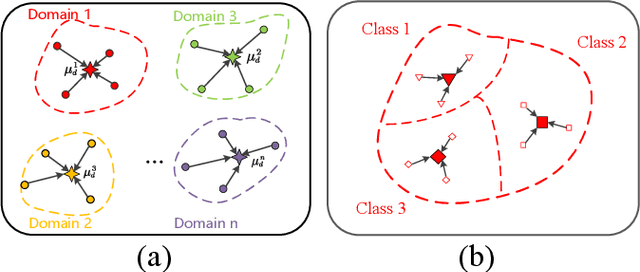
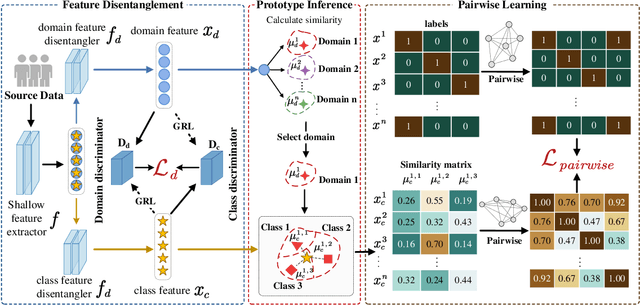
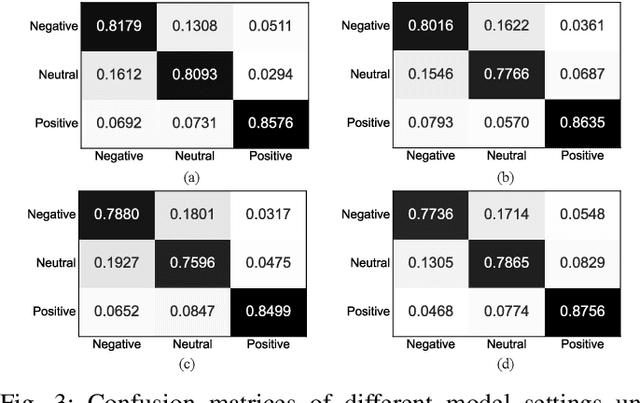
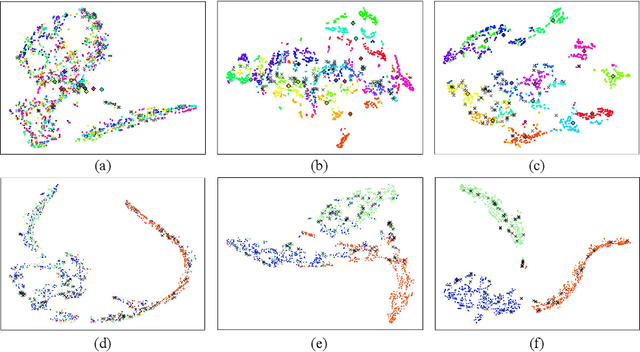
Abstract:EEG signals have emerged as a powerful tool in affective brain-computer interfaces, playing a crucial role in emotion recognition. However, current deep transfer learning-based methods for EEG recognition face challenges due to the reliance of both source and target data in model learning, which significantly affect model performance and generalization. To overcome this limitation, we propose a novel framework (PL-DCP) and introduce the concepts of feature disentanglement and prototype inference. The dual prototyping mechanism incorporates both domain and class prototypes: domain prototypes capture individual variations across subjects, while class prototypes represent the ideal class distributions within their respective domains. Importantly, the proposed PL-DCP framework operates exclusively with source data during training, meaning that target data remains completely unseen throughout the entire process. To address label noise, we employ a pairwise learning strategy that encodes proximity relationships between sample pairs, effectively reducing the influence of mislabeled data. Experimental validation on the SEED and SEED-IV datasets demonstrates that PL-DCP, despite not utilizing target data during training, achieves performance comparable to deep transfer learning methods that require both source and target data. This highlights the potential of PL-DCP as an effective and robust approach for EEG-based emotion recognition.
NSSI-Net: Multi-Concept Generative Adversarial Network for Non-Suicidal Self-Injury Detection Using High-Dimensional EEG Signals in a Semi-Supervised Learning Framework
Oct 16, 2024
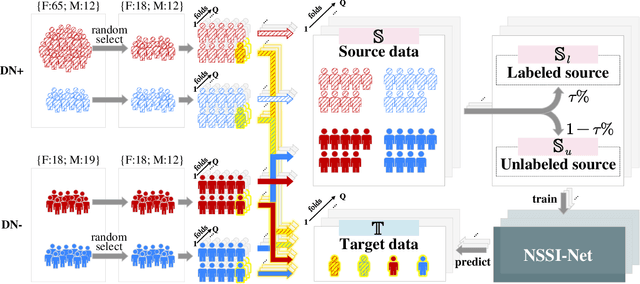
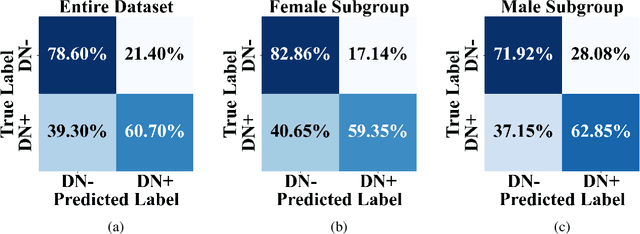

Abstract:Non-suicidal self-injury (NSSI) is a serious threat to the physical and mental health of adolescents, significantly increasing the risk of suicide and attracting widespread public concern. Electroencephalography (EEG), as an objective tool for identifying brain disorders, holds great promise. However, extracting meaningful and reliable features from high-dimensional EEG data, especially by integrating spatiotemporal brain dynamics into informative representations, remains a major challenge. In this study, we introduce an advanced semi-supervised adversarial network, NSSI-Net, to effectively model EEG features related to NSSI. NSSI-Net consists of two key modules: a spatial-temporal feature extraction module and a multi-concept discriminator. In the spatial-temporal feature extraction module, an integrated 2D convolutional neural network (2D-CNN) and a bi-directional Gated Recurrent Unit (BiGRU) are used to capture both spatial and temporal dynamics in EEG data. In the multi-concept discriminator, signal, gender, domain, and disease levels are fully explored to extract meaningful EEG features, considering individual, demographic, disease variations across a diverse population. Based on self-collected NSSI data (n=114), the model's effectiveness and reliability are demonstrated, with a 7.44% improvement in performance compared to existing machine learning and deep learning methods. This study advances the understanding and early diagnosis of NSSI in adolescents with depression, enabling timely intervention. The source code is available at https://github.com/Vesan-yws/NSSINet.
Contrastive Learning-based User Identification with Limited Data on Smart Textiles
Sep 06, 2024



Abstract:Pressure-sensitive smart textiles are widely applied in the fields of healthcare, sports monitoring, and intelligent homes. The integration of devices embedded with pressure sensing arrays is expected to enable comprehensive scene coverage and multi-device integration. However, the implementation of identity recognition, a fundamental function in this context, relies on extensive device-specific datasets due to variations in pressure distribution across different devices. To address this challenge, we propose a novel user identification method based on contrastive learning. We design two parallel branches to facilitate user identification on both new and existing devices respectively, employing supervised contrastive learning in the feature space to promote domain unification. When encountering new devices, extensive data collection efforts are not required; instead, user identification can be achieved using limited data consisting of only a few simple postures. Through experimentation with two 8-subject pressure datasets (BedPressure and ChrPressure), our proposed method demonstrates the capability to achieve user identification across 12 sitting scenarios using only a dataset containing 2 postures. Our average recognition accuracy reaches 79.05%, representing an improvement of 2.62% over the best baseline model.
Emotion-Agent: Unsupervised Deep Reinforcement Learning with Distribution-Prototype Reward for Continuous Emotional EEG Analysis
Aug 22, 2024Abstract:Continuous electroencephalography (EEG) signals are widely used in affective brain-computer interface (aBCI) applications. However, not all continuously collected EEG signals are relevant or meaningful to the task at hand (e.g., wondering thoughts). On the other hand, manually labeling the relevant parts is nearly impossible due to varying engagement patterns across different tasks and individuals. Therefore, effectively and efficiently identifying the important parts from continuous EEG recordings is crucial for downstream BCI tasks, as it directly impacts the accuracy and reliability of the results. In this paper, we propose a novel unsupervised deep reinforcement learning framework, called Emotion-Agent, to automatically identify relevant and informative emotional moments from continuous EEG signals. Specifically, Emotion-Agent involves unsupervised deep reinforcement learning combined with a heuristic algorithm. We first use the heuristic algorithm to perform an initial global search and form prototype representations of the EEG signals, which facilitates the efficient exploration of the signal space and identify potential regions of interest. Then, we design distribution-prototype reward functions to estimate the interactions between samples and prototypes, ensuring that the identified parts are both relevant and representative of the underlying emotional states. Emotion-Agent is trained using Proximal Policy Optimization (PPO) to achieve stable and efficient convergence. Our experiments compare the performance with and without Emotion-Agent. The results demonstrate that selecting relevant and informative emotional parts before inputting them into downstream tasks enhances the accuracy and reliability of aBCI applications.
EEG-SCMM: Soft Contrastive Masked Modeling for Cross-Corpus EEG-Based Emotion Recognition
Aug 17, 2024



Abstract:Emotion recognition using electroencephalography (EEG) signals has garnered widespread attention in recent years. However, existing studies have struggled to develop a sufficiently generalized model suitable for different datasets without re-training (cross-corpus). This difficulty arises because distribution differences across datasets far exceed the intra-dataset variability. To solve this problem, we propose a novel Soft Contrastive Masked Modeling (SCMM) framework. Inspired by emotional continuity, SCMM integrates soft contrastive learning with a new hybrid masking strategy to effectively mine the "short-term continuity" characteristics inherent in human emotions. During the self-supervised learning process, soft weights are assigned to sample pairs, enabling adaptive learning of similarity relationships across samples. Furthermore, we introduce an aggregator that weightedly aggregates complementary information from multiple close samples based on pairwise similarities among samples to enhance fine-grained feature representation, which is then used for original sample reconstruction. Extensive experiments on the SEED, SEED-IV and DEAP datasets show that SCMM achieves state-of-the-art (SOTA) performance, outperforming the second-best method by an average accuracy of 4.26% under two types of cross-corpus conditions (same-class and different-class) for EEG-based emotion recognition.
DuA: Dual Attentive Transformer in Long-Term Continuous EEG Emotion Analysis
Jul 30, 2024
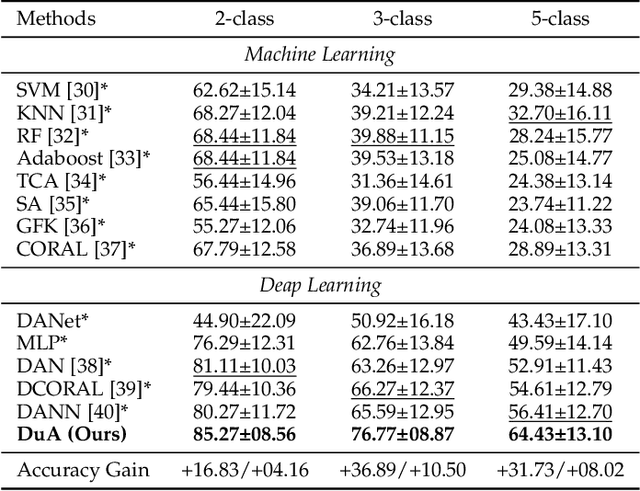
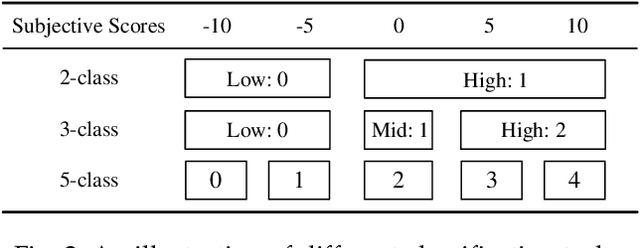

Abstract:Affective brain-computer interfaces (aBCIs) are increasingly recognized for their potential in monitoring and interpreting emotional states through electroencephalography (EEG) signals. Current EEG-based emotion recognition methods perform well with short segments of EEG data. However, these methods encounter significant challenges in real-life scenarios where emotional states evolve over extended periods. To address this issue, we propose a Dual Attentive (DuA) transformer framework for long-term continuous EEG emotion analysis. Unlike segment-based approaches, the DuA transformer processes an entire EEG trial as a whole, identifying emotions at the trial level, referred to as trial-based emotion analysis. This framework is designed to adapt to varying signal lengths, providing a substantial advantage over traditional methods. The DuA transformer incorporates three key modules: the spatial-spectral network module, the temporal network module, and the transfer learning module. The spatial-spectral network module simultaneously captures spatial and spectral information from EEG signals, while the temporal network module detects temporal dependencies within long-term EEG data. The transfer learning module enhances the model's adaptability across different subjects and conditions. We extensively evaluate the DuA transformer using a self-constructed long-term EEG emotion database, along with two benchmark EEG emotion databases. On the basis of the trial-based leave-one-subject-out cross-subject cross-validation protocol, our experimental results demonstrate that the proposed DuA transformer significantly outperforms existing methods in long-term continuous EEG emotion analysis, with an average enhancement of 5.28%.
Enhancing Diagnostic Reliability of Foundation Model with Uncertainty Estimation in OCT Images
Jun 18, 2024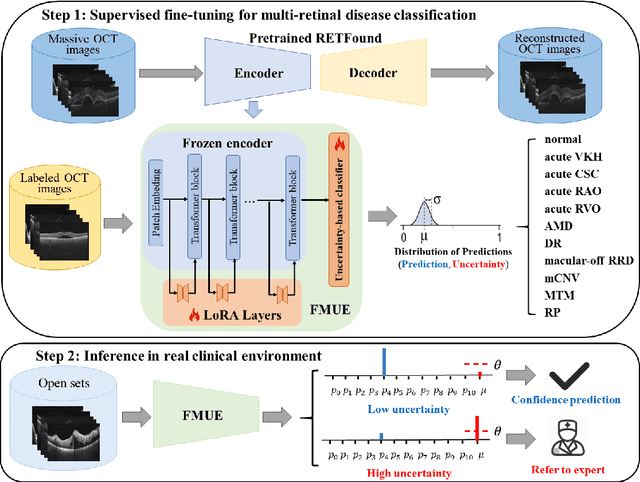
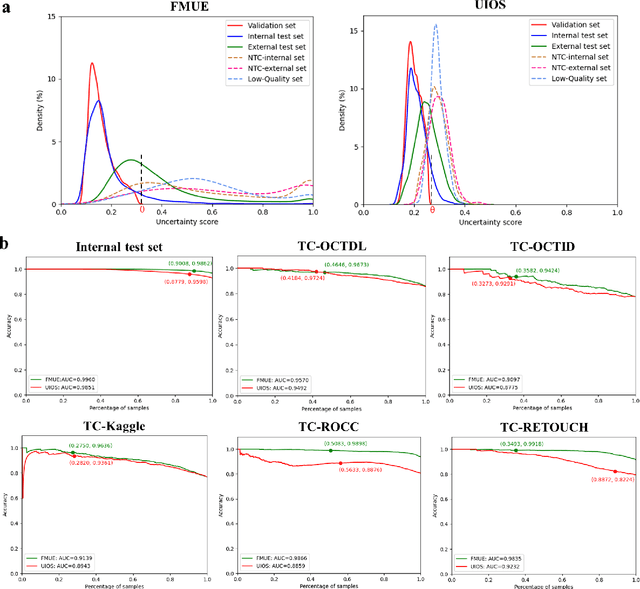
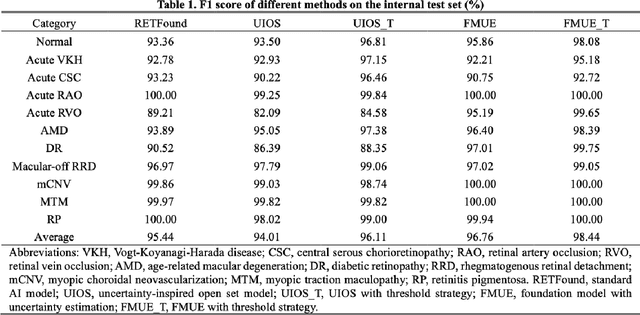
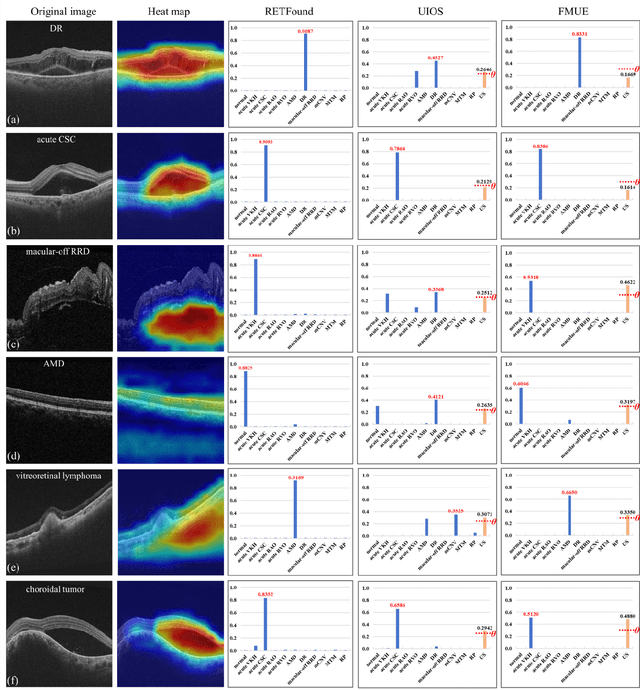
Abstract:Inability to express the confidence level and detect unseen classes has limited the clinical implementation of artificial intelligence in the real-world. We developed a foundation model with uncertainty estimation (FMUE) to detect 11 retinal conditions on optical coherence tomography (OCT). In the internal test set, FMUE achieved a higher F1 score of 96.76% than two state-of-the-art algorithms, RETFound and UIOS, and got further improvement with thresholding strategy to 98.44%. In the external test sets obtained from other OCT devices, FMUE achieved an accuracy of 88.75% and 92.73% before and after thresholding. Our model is superior to two ophthalmologists with a higher F1 score (95.17% vs. 61.93% &71.72%). Besides, our model correctly predicts high uncertainty scores for samples with ambiguous features, of non-target-category diseases, or with low-quality to prompt manual checks and prevent misdiagnosis. FMUE provides a trustworthy method for automatic retinal anomalies detection in the real-world clinical open set environment.
EEG-MACS: Manifold Attention and Confidence Stratification for EEG-based Cross-Center Brain Disease Diagnosis under Unreliable Annotations
Apr 29, 2024



Abstract:Cross-center data heterogeneity and annotation unreliability significantly challenge the intelligent diagnosis of diseases using brain signals. A notable example is the EEG-based diagnosis of neurodegenerative diseases, which features subtler abnormal neural dynamics typically observed in small-group settings. To advance this area, in this work, we introduce a transferable framework employing Manifold Attention and Confidence Stratification (MACS) to diagnose neurodegenerative disorders based on EEG signals sourced from four centers with unreliable annotations. The MACS framework's effectiveness stems from these features: 1) The Augmentor generates various EEG-represented brain variants to enrich the data space; 2) The Switcher enhances the feature space for trusted samples and reduces overfitting on incorrectly labeled samples; 3) The Encoder uses the Riemannian manifold and Euclidean metrics to capture spatiotemporal variations and dynamic synchronization in EEG; 4) The Projector, equipped with dual heads, monitors consistency across multiple brain variants and ensures diagnostic accuracy; 5) The Stratifier adaptively stratifies learned samples by confidence levels throughout the training process; 6) Forward and backpropagation in MACS are constrained by confidence stratification to stabilize the learning system amid unreliable annotations. Our subject-independent experiments, conducted on both neurocognitive and movement disorders using cross-center corpora, have demonstrated superior performance compared to existing related algorithms. This work not only improves EEG-based diagnostics for cross-center and small-setting brain diseases but also offers insights into extending MACS techniques to other data analyses, tackling data heterogeneity and annotation unreliability in multimedia and multimodal content understanding.
MDDD: Manifold-based Domain Adaptation with Dynamic Distribution for Non-Deep Transfer Learning in Cross-subject and Cross-session EEG-based Emotion Recognition
Apr 24, 2024Abstract:Emotion decoding using Electroencephalography (EEG)-based affective brain-computer interfaces represents a significant area within the field of affective computing. In the present study, we propose a novel non-deep transfer learning method, termed as Manifold-based Domain adaptation with Dynamic Distribution (MDDD). The proposed MDDD includes four main modules: manifold feature transformation, dynamic distribution alignment, classifier learning, and ensemble learning. The data undergoes a transformation onto an optimal Grassmann manifold space, enabling dynamic alignment of the source and target domains. This process prioritizes both marginal and conditional distributions according to their significance, ensuring enhanced adaptation efficiency across various types of data. In the classifier learning, the principle of structural risk minimization is integrated to develop robust classification models. This is complemented by dynamic distribution alignment, which refines the classifier iteratively. Additionally, the ensemble learning module aggregates the classifiers obtained at different stages of the optimization process, which leverages the diversity of the classifiers to enhance the overall prediction accuracy. The experimental results indicate that MDDD outperforms traditional non-deep learning methods, achieving an average improvement of 3.54%, and is comparable to deep learning methods. This suggests that MDDD could be a promising method for enhancing the utility and applicability of aBCIs in real-world scenarios.
 Add to Chrome
Add to Chrome Add to Firefox
Add to Firefox Add to Edge
Add to Edge